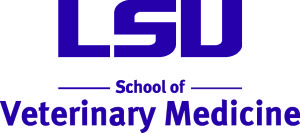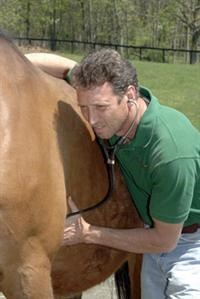Original Publish Date February 2015 If you own, ride or handle horses, it is likely that at some point your horse will experience an injury, illness or disease. Some of these incidences will be minor and will not require veterinary attention. However, for those serious events, there is a language that is important to understand and will help you effectively communicate with your veterinarian. The words within this language are fairly simple; however, under stressful situations, even the most experienced horse owner may have difficulty communicating. Therefore it is important to practice these skills and understand these words before an emergency occurs.
If you own, ride or handle horses, it is likely that at some point your horse will experience an injury, illness or disease. Some of these incidences will be minor and will not require veterinary attention. However, for those serious events, there is a language that is important to understand and will help you effectively communicate with your veterinarian. The words within this language are fairly simple; however, under stressful situations, even the most experienced horse owner may have difficulty communicating. Therefore it is important to practice these skills and understand these words before an emergency occurs.
1. TEMPERATURE – A horse’s normal rectal body temperature is 100.5 degrees (99-101.5 range). A healthy horse’s temperature can vary by 3 degrees depending on environmental factors. Horses tend to have higher temperatures in warm weather and during and after exercise, stress or excitement. A high fever doesn’t always indicate a severe condition, but it is a good idea to take your horse’s temperature often, and if his temperature is over 102 degrees, you should call your veterinarian. How to Take a Horse’s Temperature: The most accurate way to take a horse’s temperature is rectally. Always secure a string to the end of the thermometer so that it doesn’t get lost. Tack shops and pharmacies sell all types of thermometers. Plastic digital thermometers work very well and are generally easier to use. Most of them beep when they are done. Be sure that if you use an older mercury-type thermometer, you shake down the mercury before taking the horse’s temperature. The horse should be tied, or held still, by an assistant. Lubricate the tip of the thermometer with petroleum jelly or Vaseline. Move the horse’s tail to the side and out of the way and insert the thermometer into the horse’s rectum, angled slightly toward the ground. Do not stand directly behind the horse. For the most accurate reading, leave the thermometer in position for at least 3 minutes. Many digital thermometers work well in less than 1 minute. Always clean the thermometer well before returning it to its case, especially if used on an ill horse, to prevent the spreading of an illness.
2. PULSE – Normal heart rate for an adult horse at rest is an average 35-40 beats per minute. A pulse rate of 50 or higher in an adult horse at rest may mean the horse is in physical distress. The average rates for young horses are as follows: FOALS (70-120 bpm), YEARLINGS (45-60 bpm), and 2-YEAR-OLDS (40-50 BPM). The horse’s pulse rate will increase if he is excited or nervous, in pain, during/after exercise, or has a disease. As a rule of thumb, the higher the heart rate, the more severe the condition. How to take a pulse: The facial artery can be found at the bottom side of the jaw where it crosses over the bone. Count the beats for 15 seconds and multiply by four to achieve beats per minute. You can use a stethoscope to listen to the heart beating in the chest. Place the stethoscope on the left side of the chest just behind the elbow. It is often easier to hear if that leg is forward. You will have to apply some pressure to hear it. Each “lub-dub” is one beat. Again, count for 15 seconds and multiply by four.
3. RESPIRATION – The average respiration rate of an adult at rest is 8-15 breaths per minute. A horse’s respiration rate increases with hot or humid weather, exercise, fever or pain. Rapid breathing at rest should receive veterinary attention, and keep in mind that the respiration rate should never exceed the pulse rate. A horse should spend equal time inhaling and exhaling. How to take the respiration rate: Watch or feel horse’s ribcage/belly for one minute. Be sure to count 1 inhale and 1 exhale as one breath (not as two). Each breath is fairly slow. If you are having difficulty seeing the ribcage move, try watching the horse’s nostrils or place your hand in front of the nostrils to feel the horse exhale. You can also use a stethoscope to listen to your horse’s trachea or listen to his lungs. Note any funny sounds you hear; crackling, squeaking or rattling.
4. GUT SOUNDS – The gut sounds that come from your horse’s stomach and intestines can be very important information for your vet to diagnose an illness. Gut sounds should always be present. On average, a healthy horse will produce 3-4 gurgling sounds per minute. The absence of gut sounds is more indicative of a problem than excessive gut sounds. Usually, an absence of gut sounds indicates colic. If you don’t hear any sounds, contact your veterinarian. How to check for gut sounds: To check for gut sounds, press a stethoscope or your ear up against your horse’s barrel just behind his last rib. Be sure to check gut sounds from both sides.
5. DEHYDRATION – Healthy horses drink a minimum of 5 gallons of water per day. If your horse is dehydrated, it is very important that you urge him to drink. If he refuses to drink water, try adding flavor to it (Gatorade or apple juice), and contact your veterinarian if he still won’t drink. How to perform a Pinch Test: Pinch the skin on your horse’s neck. If the skin flattens back into place when you let go in less than 1 second, that is considered normal. If it doesn’t, it means he isn’t drinking enough water and may be dehydrated. The longer the skin stays pinched up before flattening, the more dehydrated he is.
6. CAPILLARY REFILL TIME (CRT) – Capillary Refill Time is the time it takes for blood to return to blanched tissues in the gums. This is an indicator of blood circulation and can be used as a measure of dehydration as well. Normal refill time is 1 to 2 seconds. How to check CRT: Lift your horse’s upper lip up and firmly press your thumb against his gums for 2 seconds to create a white mark. This white mark should return to the normal pink color within 1-2 seconds after releasing the pressure.
7. MUCOUS MEMBRANES – The mucous membranes are the lining of a horse’s eyelids, the gums and the inside of his nostrils. The colors of the mucous membranes are another indicator of blood circulation. A healthy horse’s gums are slightly more pale than a human’s. If a horse’s gums are very pale, bright red, grayish blue or bright yellow, call a veterinarian immediately. Dry gums or gums that feel sticky indicate the horse may be dehydrated.
Moist Pink: Healthy normal circulation.
Very Pale Pink: Capillaries contracted; can be an indication of fever, blood loss or anemia.
Bright Red: Capillaries enlarged indicate toxicity or mild shock.
Gray or Blue: Severe shock, depression and illness.
Bright Yellow: Associated with liver problems. Keep your equine vital information where you can refer to it when necessary. Practicing these skills provides a number of benefits. You will become more familiar with the language that is necessary to communicate effectively with your veterinarian and what is “normal” for your horse, and you will be more prepared to handle an emergency. Always, when in doubt, call your veterinarian for guidance and information concerning the health and well-being of your horses.





